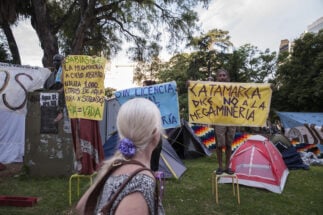Around 18,500 Rohingya refugees on Bhashan Char heaved a sigh of relief as Cyclone Yaas veered in the Bay of Bengal and hit the Odisha-West Bengal coast on 26 May. But they know they are living on the most cyclone-vulnerable spot of the world’s most cyclone-prone sea: an island at the mouth of an estuary, whose funnelling effect magnifies the impacts of the deadly storms.
The refugees who fled ethnic cleansing in Myanmar did not go to Bhashan Char, which was previously uninhabited, by choice. In December 2020, they were relocated from refugee camps in mainland south-eastern Bangladesh, despite warnings from international agencies about the vulnerability of the island to cyclones, erosion and sea level rise.
Bhashan Char formed less than 20 years ago at the estuary of the Meghna river with silt from the Ganga, Brahmaputra and Meghna. Much of the 40-square-kilometre island rose above the sea level as recently as 2006.
The island is between Sandwip and Hatia islands, close to the small town of Bhola – all infamous names in the history of cyclones. They are at the northern end of the Bay of Bengal, which occupies 0.6% of the global ocean area but accounts for 80% of all cyclone deaths.
Rohingyas live in fear
Abdul Malek’s neighbours in the mainland refugee camp urged him not to relocate to Bhashan Char. But he had heard about the embankment and the cyclone shelters. He wanted to get out of the overcrowded camp. And his family was thrilled to move from their mud huts to concrete housing built by the authorities.
All that has changed. Speaking on the phone from the island, Malek said he and his family were terrified when they heard about the formation of Cyclone Yaas. “I am now worried about what will happen if a severe cyclone washes the embankment away. This place is totally cut off from the mainland. Nobody will be able to rescue us from a disaster.”
This place is totally cut off from the mainland. Nobody will be able to rescue us from a disasterAbdul Malek
“We hope nothing will happen,” said Ikram Hossen, another resident. “But if it happens, we are totally isolated.” The island is 60 km from the mainland.
Manjur Alam Majhi, a Rohingya community leader living in Bhashan Char, said: “We are familiar with disasters and hostile coastal environments. We haven’t faced such a situation yet in Bhashan Char. But looking at the large buildings, it seems that there will be no danger.”
Unrest on Bhashan Char
The residents of Bhashan Char have no means of earning a living and are totally dependent on handouts. Majeda Begum, a 30-year-old resident, said: “Our lives depend on the rations provided by the government. There is no way that we can buy fish, meat or vegetables as there is no income. Soap or other hygiene materials are not included in the [relief] package. This is a big problem that we face every day as far as hygiene and sanitation are concerned.”
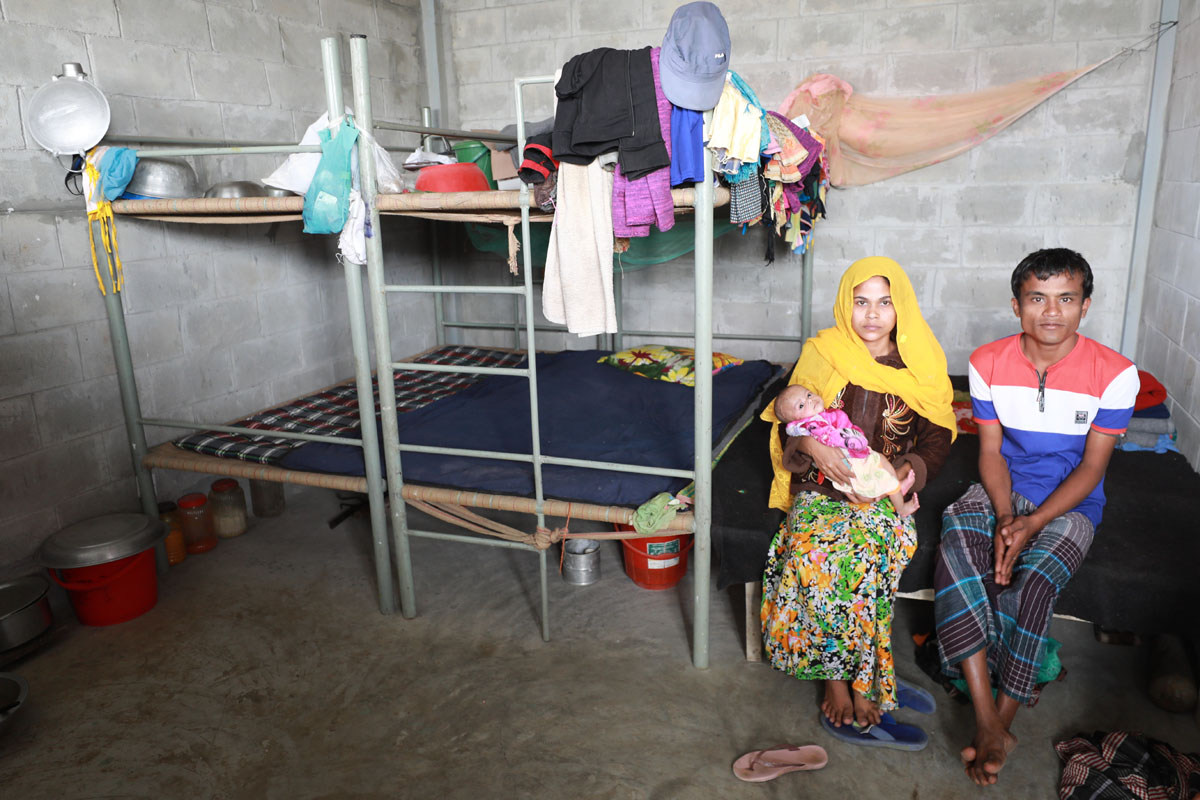
On 31 May, thousands of Rohingya protested against the conditions on the island. Immediately before the protests, there were reports of refugees attempting to flee Bhashan Char. One woman told journalists that she had paid 30,000 Bangladeshi Taka (USD 350) to a broker to be taken back to the refugee camp at Cox’s Bazar, where her family is.
Officials have contradicted the allegations about poor conditions, saying there are solar panels for electricity, biogas for cooking, a waste-management system and a mobile phone network, as well as homes and cyclone shelters. Journalists who have been to the island have found that the network for mobile phones is weak.
Displaced again and again
Bangladesh now hosts 1.1 million Rohingya refugees. Most fled Rakhine state of Myanmar during the worst bout of ethnic cleansing in 2017, with some arriving before and after. Almost all are housed in overcrowded camps near the Myanmar border. Conditions are miserable and trafficking rife; so is Covid-19.
The Bangladeshi government had planned to relocate Rohingya refugees to Bhashan Char before the 2017 influx, even before the island got its current name (it was called Thengar Char). The authorities consulted international construction companies on making secure dwellings for refugees. But right from the beginning, there were objections.
The United Nations warned the Bangladesh government against moving the refugees to Bhashan Char before conducting a technical assessment of the island’s ability to withstand cyclones. There was also criticism from humanitarian agencies.
After 2017, the government decided it would relocate 100,000 refugees to Bhashan Char.
The government spent Tk 31 billion (USD 368.5 million) to build homes for refugees and secure the island. The first phase of the project was completed in 2019 by British engineering consultancy HR Wallingford and Chinese construction company Sinohydro.
The entire project is controlled by the Bangladesh Navy. It started with moving 1,642 Rohingyas on 4 December 2020. The island is home to 18,500 refugees now.

Mohammad Anower Ul Kabir, an officer in the navy, said: “The island is protected, and adequate measures have been taken to ensure the safety of the settlers with 120 concrete cyclone shelters, each with a capacity of at least 1,000 people. There is a 13-km embankment around the island.”
“During the feasibility study of the Bhashan Char Shelter Project, the pattern of cyclones in the last 176 years in the Bay of Bengal was reviewed,” Kabir added. “Work is underway to raise the 9-foot [3-metre] high embankment to 19 feet (6 metres) around Bhashan Char following the Bangladesh Water Development Board standard. This is expected to be completed in 2021.”
Not all refugees relocated happily
After the first batch of relocations, Amnesty International called for an immediate halt. Its South Asia campaigner Saad Hammadi said: “The authorities should immediately halt relocation of more refugees to Bhashan Char and return those on the island to their families and community in mainland Bangladesh. The relocation of so many Rohingya refugees to a remote island, which is still off-limits to everyone including rights groups and journalists without prior permission, poses grave concerns about independent human rights monitoring.”
Amnesty said it had interviewed a number of refugees who were on the government’s relocation list, and had been told by representatives of five family members (23 people in all) that they had signed up to relocate out of compulsion rather than choice.
Hammadi had urged the government to let the United Nations, rights groups and humanitarian agencies carry out independent assessments of Bhashan Char’s habitability before taking any steps to relocate people there.
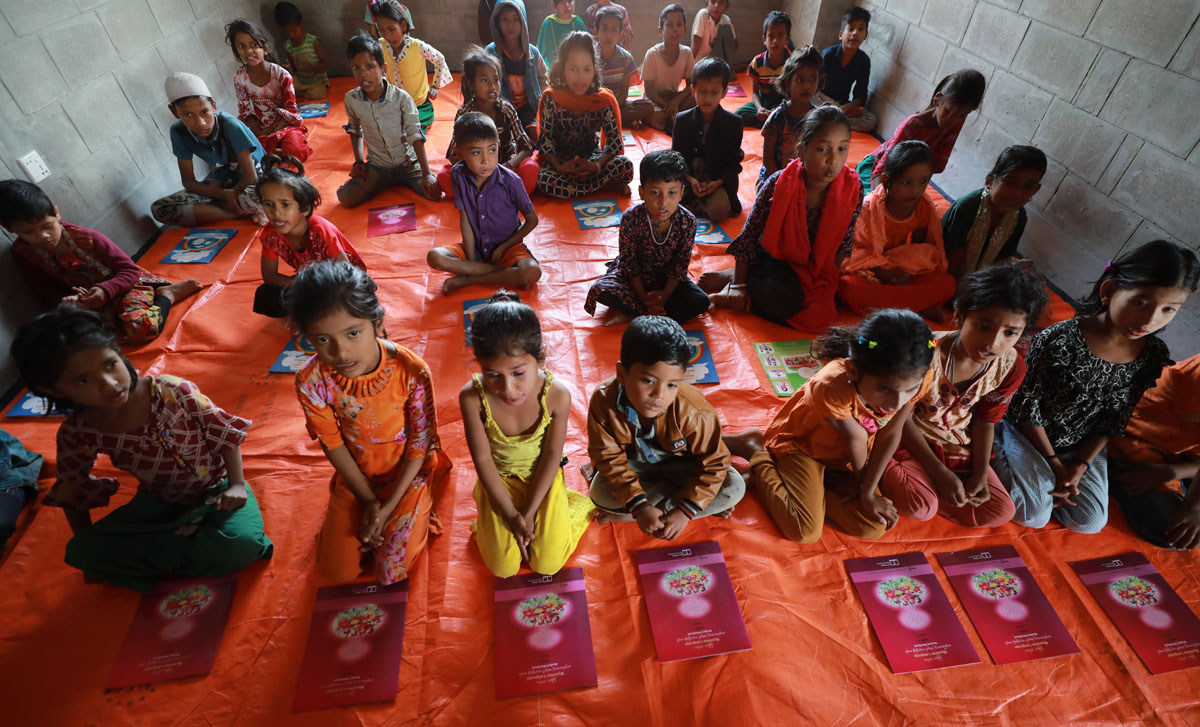
Brad Adams, Asia director at Human Rights Watch, had said in a statement: “The Bangladesh government is actively reneging on its promise to the UN not to relocate any refugees to Bhashan Char until humanitarian experts give a green light. If the government were genuinely confident in the habitability of the island, they would be transparent and not hastily circumvent UN technical assessments.”
Cyclone danger ever-present
In the Meghna estuary, a high tide can raise the water level by 7 metres, according to Mohammad Nasir Uddin, executive engineer of the Bangladesh Water Development Board. Since 1960, at least five deadly cyclones have hit this part of the Bay of Bengal coast. Residents of all islands near Bhashan Char remember the trauma.
Mohammad Fakir, 50, used to graze his buffaloes on Subarno Char, which was once an island near Bhashan Char but is now part of the mainland. “I remember I had to swim for at least 10 kilometres with a few of my buffaloes when a cyclone hit that island in 1991,” he told The Third Pole. “Sometimes I can’t explain to myself how I survived. I used to graze buffaloes on two other islands before. One of them, called Noler Char, disappeared due to severe erosion.”
When cyclones form in the Bay of Bengal, the wind and the waves cannot dissipate because the world’s largest bay is landlocked except in the south. When the mega-storms slam into land near a river mouth, much of the energy they have accumulated is funnelled up the rivers, making the estuaries extremely vulnerable to cyclone damage.
Preparing for Cyclone Yaas
As it happened, Cyclone Yaas made landfall almost 600 km to the west of Bhashan Char. But the authorities did make arrangements. Mohammad Khorshed Alam Khan, deputy commissioner of Noakhali district, which encompasses Bhashan Char, said dry food had been stockpiled and rescue workers sent.
Cyclones can devastate large areas. In 2020, Cyclone Amphan made landfall in West Bengal, India, but the tidal surge engulfed the Bhashan Char market, which was outside the embankment. (The market was created before the Rohingyas were moved to the island to cater for construction workers.)
The United Nations and other aid agencies recently visited Bhashan Char twice and called for an emergency management plan. “The UN team recognises the extensive investments made by the government in Bhashan Char, including the facilities and infrastructure and other offshore coastal protection measures,” Charlie Goodlake, UN Refugee Agency spokesperson in Dhaka, said after the first visit. “To further mitigate risks, the UN believes it might be critical to also put in situ an emergency management plan within the case of severe weather events, including the pre-positioning of essential supplies and goods on the island.” The demonstration by residents took place during the second visit by UN officials.
As Cyclone Yaas veered westwards, water resources and climate change specialist Ainun Nishat told The Third Pole that residents of Bhashan Char would not have much to fear from it. “There are shelters for 100,000 Rohingyas in Bhashan Char…. The settlement is protected by an embankment.” He also pointed out that “in Bangladesh, there are many islands in that area where many people are living in unprotected settlements.”
Names of Bhashan Char residents have been changed on their request
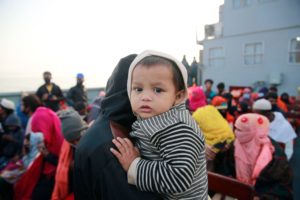


![The IUCN team training refugees on how best to respond to elephants [image by: IUCN/Tarik Kabir M.A. Motaleb]](https://dialogue.earth/content/uploads/2018/05/elephant-training-300x165.jpg)
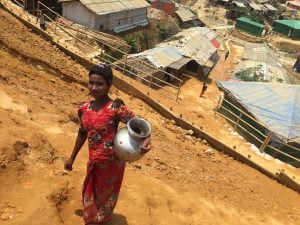
![man collecting firewood in Rohingya [image by: Mokammel Shuvo]](https://dialogue.earth/content/uploads/2018/03/Roh1-300x200.jpg)
